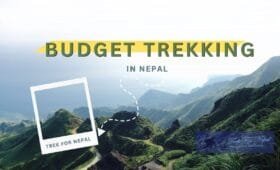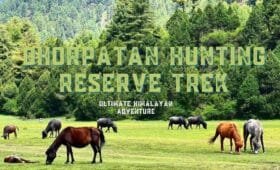The Makalu Base Camp Trek is a raw, awe-inspiring expedition that leads trekkers to the foot of Mount Makalu, the world’s fifth-highest peak, rising to 8,463 meters. This adventure remains underexplored compared to more commercial routes, guaranteeing solitude and the thrill of forging your path through pristine forests, high-altitude passes, and culturally diverse communities. The Makalu Base Camp Trek itinerary typically spans multiple weeks, weaving through far-flung villages, terraced fields, and eventually glacial terrain near the base camp. If you’re eager to escape busier circuits like Everest or Annapurna, the Makalu Base Camp Trek is an enticing option that demands both physical fitness and a spirit of adventure.
In this comprehensive Makalu Base Camp Trek Guide articles, we will explore every essential detail of the Trek—from cost factors like permits and gear to recommended months for optimal weather, route highlights, logistic tips, and how to integrate your trek with meaningful community work through Volunteers Initiative Nepal (ViN). Whether you are a seasoned Himalayan traveler or a daring enthusiast prepared for high-altitude exploration, the Trek guarantees unparalleled scenery, authentic cultural encounters, and the fulfillment of conquering a less-traveled path in Nepal’s remote eastern frontiers.
Introduction
1. Introduction: Why the Makalu Base Camp Trek?
The Makalu Base Camp Trek beckons those seeking pristine wilderness and a challenging, high-altitude climb away from mass tourism. The route skirts Makalu Barun National Park, renowned for its dramatic topography and biodiversity, ranging from subtropical valleys to alpine meadows. Trekkers ascend through thick rhododendron forests, traverse fast-flowing rivers, and ultimately scale passes above 4,000 meters to approach the majestic Makalu Base Camp at approximately 4,870 meters.
Statistic: According to Nepal Tourism Board estimates, fewer than 2,000 foreign visitors trek through Makalu Barun National Park yearly, much smaller than the tens of thousands in the Annapurna or Everest areas. This underscores the region’s untouched nature. Along the way, you’ll meet Rai, Sherpa, and Limbu communities preserving centuries-old traditions. The dramatic Makalu massif in the distance anchors the entire journey.
Quote:
“The Makalu Base Camp Trek tested my endurance but rewarded me with mesmerizing glacier views and an authentic cultural immersion. It felt like an undiscovered gem,” says Matthew, a 32-year-old trekker from the U.S. who finished the route last season.
2. Historical & Cultural Overview
Mount Makalu, spanning the Nepal-Tibet border, witnessed its first successful summit by a French expedition in 1955. However, its surrounding valleys stayed relatively unknown to trekkers until the 1990s, when the government created Makalu Barun National Park. The region’s local inhabitants—primarily Rai, Sherpa, and Limbu—have historically thrived through trade and subsistence agriculture. Today, these groups continue to uphold a unique blend of Buddhist and animist rituals, reflecting the area’s profound spiritual connection to nature.
Tucked into Nepal’s eastern flank, the Makalu Base Camp Trek region showcases lush farmland near the Arun River, thick pine and rhododendron forests in mid-altitudes, and harshly beautiful glacier landscapes nearing the base camp. Due to limited roads, mule caravans transport goods on foot. This fosters a sense of timelessness as you ascend, witnessing local lifestyles closely tied to the land.
Trek Itinerary
3. Key Highlights of Makalu Base Camp Trek Itinerary
A standard Makalu Base Camp Trek Itinerary often spans 18–22 days, including rest and contingency days. Below is a broad sample:
- Day 1–2: Kathmandu → Tumlingtar → Chichila (~1,980m)
A flight from Kathmandu to Tumlingtar, then a jeep or bus to Chichila for a night’s rest. Some choose to stay en route to Khandbari. - Day 3–5: Chichila → Num (~1,560m) → Seduwa (~1,540m) → Tashigaon (~2,070m)
Trails meander through farmland and small villages. Seduwa is a checkpoint for Makalu Barun National Park permits. Tashigaon is the last major settlement before higher wilderness areas. - Day 6–7: Kongma Danda (~3,560m) → Dobate (~3,500m)
Ascend through rhododendron and bamboo forests, encountering fewer teahouses as altitude gains. Kongma Danda stands as a scenic vantage. - Day 8–10: Dobate → Yangle Kharka (~3,600m) → Langmale Kharka (~4,410m)
A progressive climb along the Barun River valley. Yangle and Langmale are prime camping areas, overshadowed by looming peaks. - Day 11–12: Makalu Base Camp (~4,870m)
The trek’s highlight. Revel in views of Makalu’s south face, plus glimpses of Everest and Lhotse in the distance. Spend a rest/acclimatization day capturing panoramas. - Day 13–15: Return Journey
Retrace steps down the valley, or some choose an alternate route if conditions permit. - Day 16–18: Tashigaon → Num → Tumlingtar → Kathmandu
A final descent and ride to Tumlingtar for a return flight.
The Makalu Base Camp Trek can last more than three weeks if you add side trips like exploring the Baruntse Base Camp or combining volunteering stints in local villages.
4. Understanding the Makalu Base Camp Trek Difficulty
The difficulty of the Makalu Base Camp Trek is moderately high. Most of the route lies above 3,000 meters, culminating at base camp near 4,870 meters. The path features steep ascents and descents, with potential ice or snow beyond Yangle Kharka. Some days require 6 to 7 hours of hiking on rough terrain.
Fitness & Preparation:
- Undertake 6–8 weeks of cardio and strength routines prior (running, cycling, weighted squats).
- This trek is recommended for hikers with prior multi-day altitude trekking experience.
- Careful altitude pacing—particularly from Tashigaon onward—helps stave off sickness.
Mapping
5. Mapping Your Route: A Look at the Makalu Base Camp Trek Map
A well-detailed Makalu Base Camp Trek Map is essential, especially as lodging becomes sparse above Tashigaon. Key references:
- Tumlingtar (~285m): Trek starting point if you choose a flight from Kathmandu.
- Seduwa (~1,540m): Entry checkpoint for Makalu Barun National Park.
- Tashigaon (~2,070m): Last central village with teahouse accommodations.
- Kongma, Dobate: Mid-altitude stops or campsites.
- Yangle Kharka (~3,600m): Entering higher meadows is crucial for acclimatization.
- Langmale (~4,410m): Another campsite near the final approach to base camp.
- Makalu Base Camp (~4,870m): Scenic vantage of Makalu, Baruntse, and other majestic Himalayan summits.
Note that certain areas have minimal to no teahouse availability in some seasons, so you might need to carry camping gear. Also, landslides or monsoon washouts can shift trail segments, so checking local updates is crucial.
Costing
6. How Much Does It Cost? Explaining the Makalu Base Camp Trek Cost
The Makalu Base Camp Trek Cost often exceeds that of more popular routes, mainly due to its remote nature:
- Permits:
- Makalu Barun National Park entry (~USD 30).
- TIMS card (~USD 10–20).
- Transport:
- Flight from Kathmandu to Tumlingtar (~USD 150–200 each way).
- Alternatively, a bus or jeep from Kathmandu is cheaper (~USD 20–40) but takes longer.
- Food & Accommodation:
- Lower altitudes: teahouses at ~USD 5–8 nightly.
- Higher altitudes: may need camping. If you hire staff, budget ~USD 25–30 daily for group cooking.
- Guide & Porters:
- ~USD 25–40/day for a guide. Porters cost ~USD 15–25/day.
- Gear Rental:
- Tents, sleeping bags (~-10°C rating), cooking equipment if mostly camping.
Expect ~USD 1,500–2,300 for a 15–18 day itinerary if done with partial camping. A Makalu Base Camp Trek Package might run ~USD 2,000–2,800, covering flights, staff wages, and gear. Solo, minimal support attempts could cost slightly less but carry higher logistical complexity.
7. Booking the Right Makalu Base Camp Trek Package
Since the trek includes remote sections with few teahouses, many choose a Makalu Base Camp Trek Package from an agency that covers the following:
- Permits & Transportation: Easing potential headaches in Tumlingtar or bus journeys.
- Lodging & Meals: Combining teahouse stays at lower altitudes with camping at upper altitudes.
- Guides and porters: Licensed staff ensure route guidance, safety on glacier or snow sections, and minimal altitude sickness risk.
- Equipment: Tents, mats, cooking gear—particularly vital above Tashigaon.
Compare multiple agencies’ offerings. Some Trek Reviews mention the significance of an agency with thorough knowledge of local culture and advanced mountaineering skills if conditions get brutal near base camp or beyond.
Trek Permits
8. Securing Makalu Base Camp Trek Permits
Makalu Base Camp Trek Permits revolve around:
- Makalu Barun National Park Entry: ~USD 30.
- TIMS (Trekkers’ Information Management System) Card: ~USD 10–20.
- Possible Additional: Extra permits might apply if your route touches restricted areas near the border. However, none beyond the above are typically required for the standard itinerary.
Carry your passport, visa, and multiple photos. If going with a package or guide, they might handle the paperwork.
Season & Weather
9. Makalu Base Camp Trek Best Time: Seasons & Weather
Makalu Base Camp Trek Weather can be harsh at high altitudes. The recommended windows for the Makalu Base Camp Trek Best Time are:
Monsoon (Jun–Aug): Consistent rainfall, leeches in lower forests, potential landslides. Clear morning windows might be ephemeral, making it the least popular season.
Autumn (Sept–Nov): Clear vistas, mild day temps ~15°C at mid altitudes, sub-zero nights near base camp. The region sees increased but still modest trekker flow.
Spring (Mar-May): Blooming flora, stable mornings, potential afternoon storms. There is crisp air in upper camps and moderate nights.
Winter (Dec–Feb): There are minimal crowds, yet heavy snow may hamper passes above 4,000m, and there are sub-zero nights. More gear is essential.
10. Hiring a Makalu Base Camp Trek Guide
Though not a restricted area, the route’s remote nature prompts many to hire a Makalu Base Camp Trek Guide. Even experienced trekkers benefit:
- Route Navigation: Minimizes risk of error, especially with fewer established teahouses above Tashigaon.
- Cultural Insights: Guides interpret local customs, bridging communication gaps in Limbu or Sherpa villages.
- Safety & Logistics: They handle campsite selection, altitude pacing, and emergency responses if weather or illness arises.
Expect daily guide wages of ~USD 30–40. Some trekkers add porters at ~USD 15–25/day. Group tours typically split these costs.
Tips
11. Preparation & Tips for Success
11.1 Physical Conditioning
- Cardio: 6+ weeks of consistent running or biking 3–5 times weekly.
- Strength: Weighted stair climbs, lunges or squats replicate daily ascents.
- Backpack Training: Hike with ~8–10 kg to adapt your shoulders and legs to longer routes.
11.2 Gear & Clothing
- Layering: Thermal base, mid-layer fleece, down jacket, and waterproof shell.
- Footwear: Sturdy, broken-in boots. Possibly microspikes if bridging icy segments near spring or late autumn.
- Camping Essentials: A sleeping bag rated to -10°C or colder, a sleeping mat, and trekking poles if desired.
11.3 Altitude Strategy
Makalu Base Camp Trek Altitude surpasses 4,800m near base camp. Some side vantage points near Baruntse can approach 5,000m. Insert rest days at Tashigaon or Yangle Kharka. If you sense headaches or dizziness, slow your pace or rest an extra day.
12. Stories from the Trail: Testimonials & Inspiration
Denise’s Experience
Denise, a 30-year-old trekker from the Netherlands, shares,
“Makalu felt like a true frontier. The lack of large crowds meant every day was about forging new paths—some nights, we camped alone under a star-packed sky near Yangle Kharka. Reaching Makalu Base Camp was surreal, with the massif looming overhead.”
Local Impact
Sanu, a teahouse owner in Tashigaon, explains how occasional trekker visits help them buy seeds and maintain footpaths.
“We can’t rely on big tourism volumes. But each group invests in local guides, porters, and produce, which helps our families. We appreciate mindful travelers who respect the environment and culture.”
FAQs
13. Seven Most Frequently Asked Questions
How long is the Makalu Base Camp Trek Duration?
Typically 18–22 days, factoring in rest days and possible side excursions.
What is the Makalu Base Camp Trek Difficulty rating?
It’s considered moderately high. Robust fitness is vital, as there are multiple days above 3,500m and a peak altitude near 4,870m at the base camp.
How much does the Makalu Base Camp Trek Cost?
Expect ~USD 1,500–2,500 for a ~3-week journey, including flights, camping gear, guide wages, and daily meals.
Which Makalu Base Camp Trek Permits do I need?
Makalu Barun National Park (~USD 30) plus TIMS (~USD 10–20). No special restricted permits unless your itinerary includes adjacent restricted zones.
When is the Makalu Base Camp Trek Best Time?
Autumn (Sept–Nov) and spring (March) for stable weather, minimal storms, and mild daytime temperatures.
Should I hire a Makalu Base Camp Trek Guide?
Highly recommended, given remote campsites, altitude challenges, and minimal signage above Tashigaon.
Are teahouses available throughout the route?
Limited. Some teahouses exist below Tashigaon. Beyond that, expect partial or complete camping. Many nights might be spent in a tent near Yangle Kharka or higher.
Conclusion
Charting a path through dense forests, high ridges, and glacial vistas, the Makalu Base Camp Trek remains challenging for adventurous souls. Its demanding altitudes and lack of commercial footprints ensure each day resonates with exploration and personal growth. Meanwhile, the multi-layered cultures you encounter—from farmland villages near Seduwa to near-lunar sceneries around Makalu Base Camp—offer a tapestry of Eastern Nepal’s hidden heritage.
Community Empowerment
Weaving Community Empowerment with the Trek – ViN’s Vision
At Volunteers Initiative Nepal (ViN), we see that every Himalayan trek can become a tangible force for good:
- Share: Inspire fellow explorers to blend their trekking ambitions with philanthropic efforts—propagating a mindful, beneficial tourism culture.
- Volunteer: Dedicate a few days to teaching or supporting clinics in mid-altitude villages near Tashigaon or Seduwa.
- Donate: Your donation will help finance local educational tools, micro-infrastructure, or reforestation, ensuring a lasting impact long after you depart.
- Intern: Use your academic or professional pursuits—like ecology, healthcare, or social science—to gather valuable data or make direct improvements.
Namaste, and may your footsteps on the Makalu Base Camp Trek spark new horizons for the communities you touch. As you embrace the route’s raw challenges and scenic grandeur, remember that forging synergy between adventure and empathy can yield a legacy of positive change for the entire region.
Additional Tips
Additional Info & Practical Tips
To solidify your readiness for the Makalu Base Camp Trek, let’s explore additional details about route expansions, environmental stewardship, gear, and potential volunteering synergy.
1. Seasonal Weather & Variation
1.1 Autumn
- Clear mountain vistas, minimal rainfall, cold nights. Crisp, unobstructed views from camps near base camp.
1.2 Spring
- Blooming rhododendrons, moderate daytime warmth, potential afternoon clouds or thunderstorms. Typically, calmer passes.
1.3 Winter
- Minimal visitors, though heavy snow, can make crossing near Shershong or further advanced routes challenging. Deep freeze nights near base camp.
1.4 Monsoon
- High humidity, slick trails, daily rain. Fewer visitors, but watch out for landslides in lower sections. Morning treks might be feasible before downpours.
2. Environmental Stewardship
2.1 National Park Etiquette
Respect local flora and fauna. Avoid off-trail wandering that might damage fragile plants. Carry out all plastics or wrappers since disposal facilities remain limited.
2.2 Community Partnerships
Many local NGOs or youth clubs near Tashigaon or Seduwa appreciate assistance in reforestation or trash clean-up campaigns. Coordinate with a local guide or Makalu Base Camp Trek Package operator.
3. Altitude Realities & Safety
3.1 Acclimatization
Many opt for mild daily ascents by Tashigaon (2,070 m). It is wise to add an acclimatization day near Yangle Kharka (~3,600m). If you sense acute altitude issues, descend or rest immediately.
3.2 Rescue Options
There are no immediate roads beyond Tashigaon. Helicopter rescue from the Makalu Base Camp region is expensive and reliant on stable weather. Hence, a good insurance policy with high-altitude trekking coverage is vital.
4. Lodging & Dining Style
4.1 Teahouse vs. Camping
Makalu Base Camp Trek Accommodation often transitions from teahouses in lower villages to improvised camps above. Some teahouses have limited rooms or a bare dining hall. Tented nights offer an expedition atmosphere.
4.2 Meals
Expect dal bhat, noodles, chapati, and occasional local produce if available. Higher up, your cook or guide typically manages communal dinners with minimal variety—stock energy bars or personal snacks for extra comfort.
5. Potential Route Combinations
Some advanced trekkers incorporate an extension toward Baruntse (7,152m) or merge with a crossing into the Everest region, though that demands advanced mountaineering skills and additional permits. This synergy can exceed a month’s trekking and is truly epic, but only for those with significant Himalayan experience.
6. Volunteering with ViN
6.1 Pre-/Post-Trek Projects
Volunteers Initiative Nepal can coordinate short stints in local schools or health outposts near Khandbari or Seduwa. This fosters direct cultural engagement and capacity building.
6.2 Cultural Workshops
If you have specialized skills (like teaching, carpentry, or medical training), short workshops in Tashigaon or Seduwa can positively impact local families. However, advanced planning with an agency is needed to fit it into your trek timeline.
7. Reflection & Conclusion
The Makalu Base Camp Trek invites a sense of expedition rarely found on standard Nepali circuits. Each step from the sub-tropical farmland around Tumlingtar to the formidable icefields near base camp redefines your threshold for adventure. Coupled with a philanthropic angle, your trek becomes a journey of scenic wonder and a legacy of supportive engagement with Himalayan communities.




